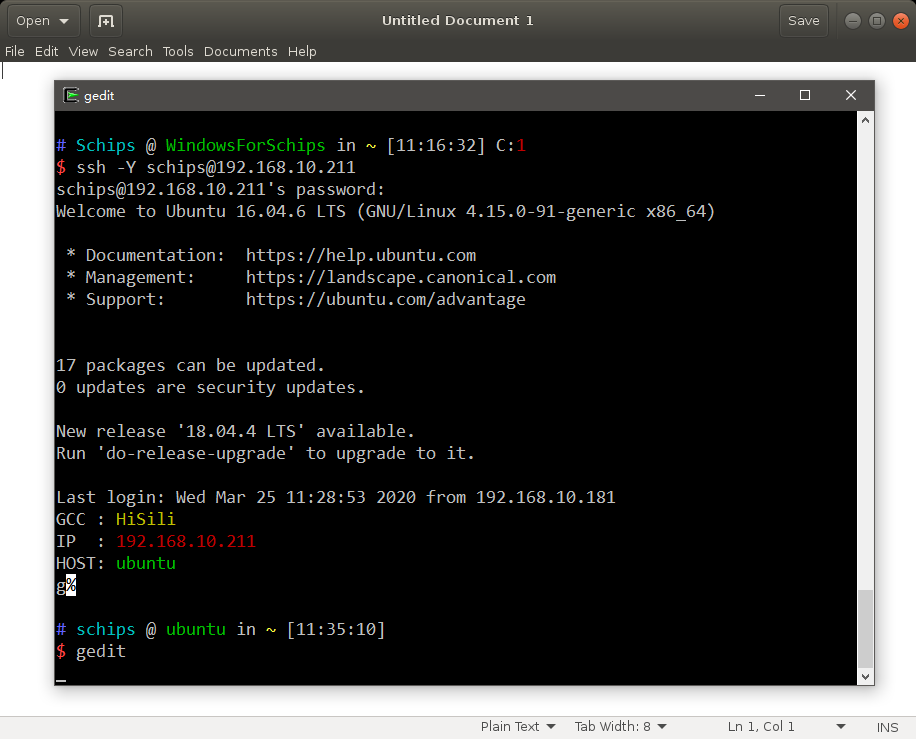If you are on a remote terminal, and the local system has only one visual (which is typical), then use the following syntax to set your user account DISPLAY environment variable:
Remote Display
The /.ssh/config file to change is the one on the client (where the keyboard is, usually). As for #2 (and 3), remember that ForwardX11Trusted doesn't imply ForwardX11. ForwardX11Trusted just means that if you turn on forwarding (whether via config file or command line) then the forwarded. I still receive the following when ssh into the server and trying to run xclock. Xclock Error: Can't open display: Here are some details. Server side (ubuntu laptop) /etc/ssh/sshdconfig. X11Forwarding yes X11DisplayOffset 10 which xauth /usr/bin/xauth Client Side (raspberry pi) /.ssh/config. ForwardX11 yes ForwardAgent yes. Using any text editor, edit or create the software installation owner's /.ssh/config file. Ensure that the ForwardX11 attribute in the /.ssh/config file is set to no. For example: Host. ForwardX11 no; Ensure that the permissions on /.ssh are secured to the Oracle installation owner user account.
Bourne, Korn, and Bash shellsC shellFor example, if you are using the Bash shell and if your host name is local_host, then enter the following command:
X11 Forwarding
To ensure that X11 forwarding does not cause the installation to fail, use the following procedure to create a user-level SSH client configuration file for Oracle installation owner user accounts:
Using any text editor, edit or create the software installation owner's
~/.ssh/config file.Ensure that the
ForwardX11attribute in the~/.ssh/configfile is set tono. For example:Ensure that the permissions on
~/.sshare secured to the Oracle installation owner user account. For example:
Parent topic:Creating Operating System Oracle Installation User Accounts
If you want to use Linux GUI apps in a remote server from your Windows 10 computer, you can use the X11 forwarding feature in SSH servers such as OpenSSH. In order to use this feature, you first need to check if your server can be connected via SSH clients and its X11 forwarding feature is enabled. You can then use any SSH client that also supports X11 forwarding.

You should be able to find the X11 forwarding option in most SSH clients. For example, our Token2Shell has this option as 'Enable X11 Forwarding' under its 'connection' settings. In an OpenSSH client, you can enable it with a '-X' or '-Y' command argument.
Forwardx11 Ssh Config
After logging into your server with X11 forwarding via an SSH client, just make sure X410 is running before launching Linux GUI apps in your server.
Please note that when you connect to your server with X11 forwarding, the server automatically sets the 'DISPLAY' environment variable. So if you modified your login script to manually set the 'DISPLAY' environment variable, you should remove it and use the automatically provided one.
Vscode Ssh Forwardx11
Please also note that the X11 forwarding is suitable for redirecting individual apps instead of the whole Linux GUI desktop. Even though it's very possible to redirect a full Linux desktop environment with X11 forwarding, we recommend using different tools such as RDP or VNC for such purpose. Although you cannot use X410 with such protocols and need a new setup, they should be able to provide faster response time since they are designed and optimized for such usage scenarios.
